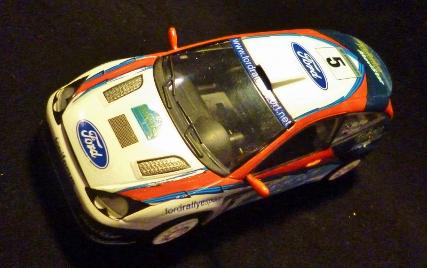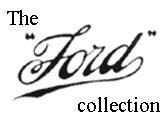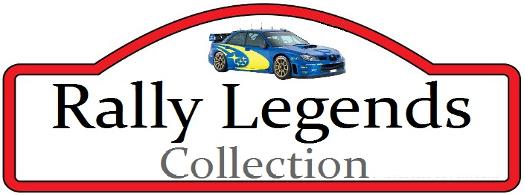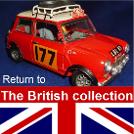
2002 Ford Focus RS WRC McCrea Grist #5
Given that all motor sport grew from the great City-to-City races, across all types of road construction, and in all weathers, one can see why rallying is considered by many as the purist form of motorsport, most closely related to everyday motoring and whose technical innovations are of most use to the ordinary motorist.
Ford encouraged this thinking and from the 1960s started pursuing success in most forms of motorsports. The company invested a lot of money trying to compete against Lancia and Audi (and more latterly Subaru, Citroen and Peugeot), starting a long history of competing in the world of Rallying. From the Cortinas and Falcons of the 1960s, through the Escorts of the 1970s and the Sierra Cosworths of the 1980s to the eventual replacement of the Escort series in 1999 by the Focus RS cars. Of course, not all these decades held the title of World Rally Championship but the growing popularity of rallying on TV and the birth of the WRC in 1973 signalled this was an area of growing importance to the motoring industry. Having an actual World Rally Champion driver focused public attention more than ever and every manufacturer wanted to claim the kudos that comes with such a title.
In 1999 Ford Europe and the British-based M-Sport firm combined to build a new car, the Focus RS (meaning Rallye Sport). It was based on the 2-litre Focus Climate production car, although the road car the competition variant share little in common beyond a similarity in looks. To meet the FIA specifications, and be competitive, the standard hatchback needed every aspect of its design to be reviewed. As in all forms of motorsport the car needed to meet three basic criteria; it had to be light, strong and fast.
From its debut season in 1999 the Ford Focus RS WRC was a winner and continuous development kept the Focus competitive through 2000 and 2001. But, the team had been edged out of the championship top spot each year; McRae losing the 2001 title to Richard Burns by just 2 points after he crashed out of the final event, the GB Rally. Designer Christian Loriaux was drafted in for 2002 but the car’s design was all but finished by the time he arrived. His influence would be felt in the continuous development of the car through the 2002 season and the preparations for the 2003 season.
The 2002 Focus RS had a number of changes over the 2001 car. Some were performance improvements, others due to rule changes and some to ensure the car looked sufficiently like the road going Focus so as to make the ordinary man in the street identify with the Focus more easily and, hopefully, buy one.
For competitiveness the car was given a new bonnet design with more vents to bring cool air to the engine and increase the outlet of hot air to maintain a cool engine bay. This is especially important for electronics and the 2002 Focus RS had a whole new electronics system designed by Ford subsidiary Pi Research was create. A team from Pi Research were integrated into the M-Sport base in Cumbria so the computer control systems software, and hardware, could be monitored, analysed and adjusted far more quickly than had previously been the case.
Another significant upgrade was Brembo’s weight saving braking system. The 2002 Focus RS was fitted with 14.6in ventilated discs with 8-Pot Callipers. Although they look much the same as the 2001 cars brakes they are constructed of different, lighter, materials developed by Brembo during their support of the American ‘CART’ racing series. Brembo claimed the brakes would be more effective, resist brake fade longer and still give the same pedal feedback that the drivers were used to.
OZ wheels with Pirelli tyres provided the contact with the road through an adjustable suspension system featuring MacPherson struts all round, Reiger adjustable dampers (with external reservoirs), and anti-roll bar front and rear. This allowed different sizes of wheels to be used for different road conditions. In general terms the car ran 18inch wheels on tarmac and 15inch wheels on gravel. The car also ran narrower rims for the rallies where snow and ice would be encountered.
The cars look was also changed because of FIA regulations that required a rear-view mirror on both doors. In conjunction with the new bonnet the front headlamp units were altered to incorporate the indicators so the car looked a lot more like the road going version. An added effect of this was that the new units, made from lighter carbon fibre, were also smaller and added to the ventilation space in the engine bay.
The 2002 Focus RS had a 1991cc ‘Zetec E’ inline 4cyl engine with DOHC operating 4 valves per cylinder. Fuel injection and twin Garett TR30R turbochargers gave the unit an output of 300bhp @ 6500 rpm. As the season progressed M-Sport lightened the transversely mounted engine’s crankshaft and flywheel, moved the power steering pump and created a new cylinder head, all of which pushed the engines power ratings up. A paddle-shift gear mechanism made changes Xtrac 240 Sequential 6-Speed gears safer and quicker and the handbrake was repositioned for better ergonomics. With permanent 4 wheel drive the focus could blast from 0-60mph in 4.2s. not surprising with a curb weight 1230kg and an output of 300bhp providing a power to weight ratio of 0.24 bhp/kg.
2002 season.
Ford’s third WRC season with Focus RS was a series of disappointments punctuated by great highs that promised so much for the Focus RS. The season was to involve 14 rounds across all the usual driving surface challenges. Main drivers for the team would continue to be double World Champions, Carlos Sainz and Luis Moya driving car #4, and 1995 WRC Champion Colin McRae, with co-driver Nicky Grist, using car #5.
The team also had a third driver and under new rules this driver could also score points in both the manufacturers’ and drivers’ championships at each round. Filling this role for Ford was up-and-coming Estonian driver Markko Märtin, and his British co-driver Michael Park, who left Subaru to join Ford’s 2002 team replacing François Delecour. Their car carried #6.
The 2002 Focus RS made its WRC debut at the Monte Carlo Rally, but with Colin McRae and Simon Jean-Joseph doing the driving. The car was immediately proving its pace with many fastest stage times being recorded. McRae finishes in fourth place but in final scrutineering the two Fords were both excluded for having illegal water pumps. This promise of greatness followed but utter disappointment was to become a theme for the year ahead.
After the Swedish rally came the Tour de Course where McRea crashed out and injured his hand; an injury that hampered his driving and he could only manage a single WRC point from the Rally Catalunya. The illusive victory remained just that.
In Cyprus the Fords started really well dominating the early stages of this rough gravel event. As the other team drivers fell by the wayside McRae looked well set leading the rally. Pushing himself and the car to the limit McRae had a series of incidents which culminated in him sliding back down the order to finish in sixth place overall. Promise and disappointment, again.
Then came Rally Argentina. This was a walkover by the works Peugeots of Marcus Grönholm and Richard Burns. But, they were excluded at the end of the rally and, somewhat fortuitously, Carlos Sainz and Luís Moya inherited the win.
Perhaps stung by the Sainz win in Argentina McRae was stunning at the Acropolis Rally in Greece. It was actually Märtin who led the early stages but McRae exploiting all the potential of the Focus RS put together some excellent stags and took his first win of the year.
At the 15th running of the Safari rally in Kenya McRae & Grist took another victory. Having a massive 15 minutes lead over the 2nd place car McRae became the first driver to reach 25 WRC rally wins and become the most successful rally driver to that point in time. What nobody knew was that it would be his last overall win.
After this the cycle of promise and disappointment resumed with Sainz and McRae struggling to hold on to third and fourth, respectively in the season at the end of the year. Despite the achievements of the year and the promise both McRae and Sainz left the Ford stable to join the up and coming Citroën team alongside Sébastien Loeb.
Conclusion
If Christian Loriaux had arrived too late to push the ’02 Focus to a championship then the 2003 car would prove a big step forward and win more rallies for Ford and M-Sport. The Focus RS series would go on to compete in WRC until 2011 winning the manufacturers' world championship in 2006 and 2007. During its competition career the Focus RS won a total of 44 world rallies with some of the greatest drivers of the time. It was replaced by the Ford Fiesta RS WRC in 2011 after the Fiesta RS success in the S2000 series proving its value as a base for a top-flight WRC car.













THE KIT
First released in 2004, as kit # K2001A, the Hornby “Ford Focus WRC” is to the scale most common in slot car racing; the 1/32nd scale. As Hornby were owners of Scalextric it seems perfectly reasonable for them to produce kits which appears to be an evolution of their slot car models. For instance, the part that holds the headlamp glazing in place is clear, and obviously shaped to hold a bulb so as to give the lighting effect now common in mainstream slot car racing sets.
In the past such a step has previously been undertaken by Cox, who created a number of static kits from their slot car range, and by AMT and REVELL, who have engineered static kits from their own slot car kits as well as going in the opposite direction too.
Sadly, Hornby’s kits came and went very quickly, which is a terrible shame. They are eminently buildable and there is a good range of aftermarket decals available too, but once they took over the Airfix name (a company renowned for producing some excellent 1/32nd scale kits back in the 1960/70s) Hornby dropped this series of kits. Strangely the tie-up hasn’t seen Airfix re-release these kits under their own name yet although the new kits Airfix have released do seem to have more in common with the Scalextric models than the 1/32nd scale. It has to be said there are many more cars in the Hornby stable that could be reworked by Airfix, or Hornby, and put out for sale as static model kits. Why not? Sorry we don’t know, despite trying to solicit a definite answer from both companies at different times.
So, what of our model? This model is special to the museum as it was built by Ian’s son, Laurence, the third generation of the family contributing car models to the website. Obviously a novice, Laurence has made a good job of the model straight from the box and proving the aforementioned buildability of the kit. Most of us know the problems that decals can pose for an inexperienced model maker and once again Laurence has done a more than passable job with the help of some Daco extra strong decal setting solution.
The model is painted with a mixture of paints as Ian tutored Laurence on the differences of paint mediums to give Laurence some experience. The main body colour was sprayed with Halfords White primer and Appliance white paint. The block colours were then brush applied using the Humbrol range of enamels. Some of the detail painting was done with acrylic paints from the Games Workshop Citadel range.
In the end Laurence has given the Museum another interesting model, not only for the rally history but also for the kit and model making history. Bravo Laurence, what’s coming next?


